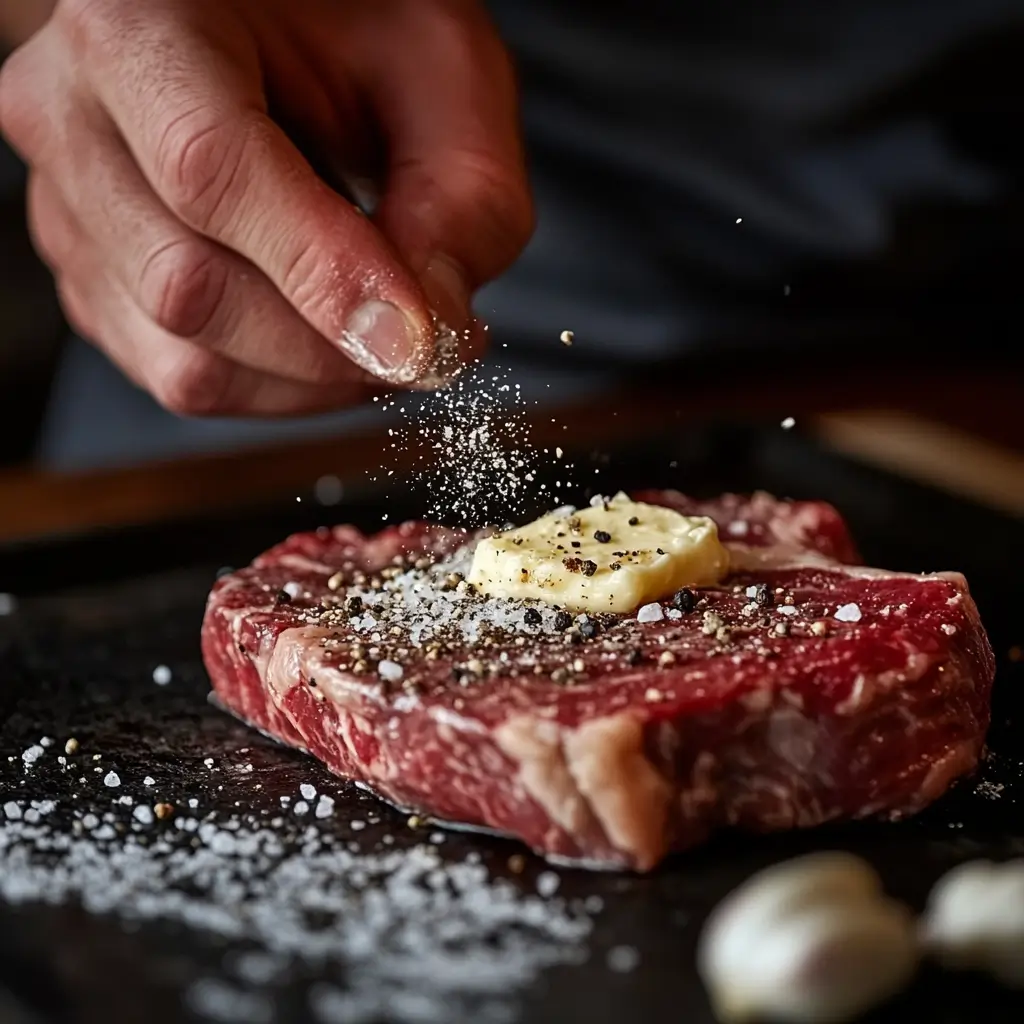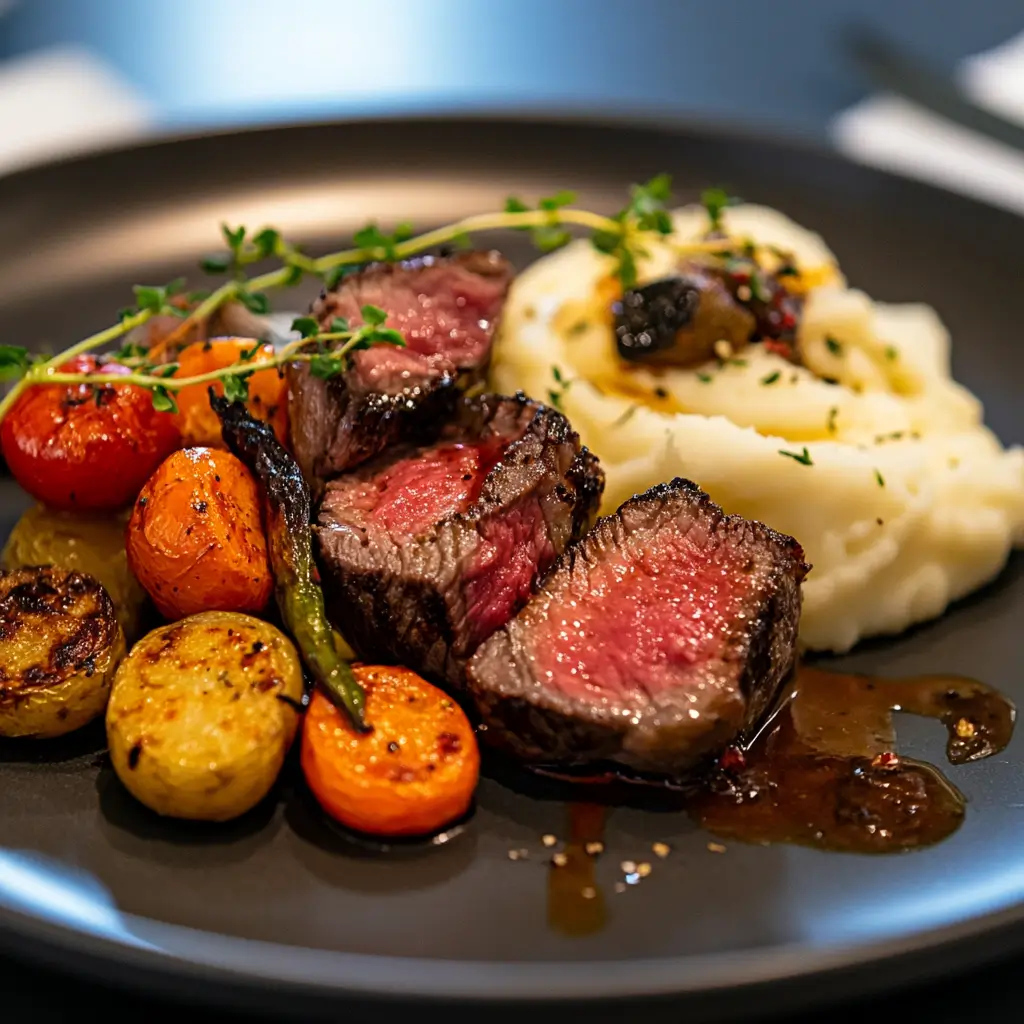Few culinary debates spark as much discussion among steak enthusiasts as the prime rib vs. ribeye showdown. Both cuts boast incredible flavor, rich marbling, and mouthwatering tenderness, yet they differ in key ways that affect their taste, texture, and cooking methods.
If you’ve ever stood at the butcher’s counter wondering, “Is prime rib better than ribeye?”, you’re not alone. Whether you’re planning a holiday feast, backyard barbecue, or steakhouse dinner, understanding the differences will help you pick the perfect cut.
Table of Contents
By the end, you’ll know exactly which steak to choose and how to cook it like a pro.
What Is the Difference Between Prime Rib and Ribeye?
At first glance, prime rib and ribeye might seem similar since they both come from the rib primal, the upper back portion of the cow. However, their preparation, cooking styles, and fat content create distinct eating experiences.
Cut Location and Butchering
Although both cuts originate from the same section of the cow, their preparation is vastly different:
- Prime rib is a large, bone-in roast typically slow-cooked to enhance tenderness. It includes the surrounding fat cap and connective tissue, which contributes to its rich, juicy flavor.
- Ribeye, on the other hand, is a single steak cut from the same section. It’s often boneless (though bone-in versions exist) and best suited for grilling or pan-searing due to its high marbling content.
Marbling and Fat Content: Why It Matters
Marbling—the thin streaks of fat within the meat—is a key factor in determining steak quality. It affects tenderness, juiciness, and overall flavor.
- Prime rib has more intramuscular fat and a thick fat cap, resulting in exceptional juiciness when slow-cooked.
- Ribeye is one of the most marbled steak cuts, giving it a buttery texture and intense beefy flavor when seared.
Taste and Texture: Which Cut Offers the Best Flavor?
Prime Rib: Rich, Buttery, and Luxuriously Tender
Prime rib’s larger size and slow-cooking process allow the fat and connective tissue to break down, creating a melt-in-your-mouth texture. The longer cooking time also enhances the beefy, roasted flavor.
🔹 Best for: Special occasions, holiday dinners, and family-style meals
🔹 Taste profile: Buttery, rich, and deeply beefy
🔹 Texture: Extremely tender and juicy, perfect for slicing
Ribeye: Bold, Beefy, and Caramelized
Ribeye is best enjoyed seared on high heat, which forms a beautiful crust while keeping the inside tender and juicy. The intense caramelization of fats and proteins creates that signature steakhouse taste.
🔹 Best for: Weeknight grilling, steak dinners, and quick high-heat cooking
🔹 Taste profile: Bold, beefy, with a smoky charred crust
🔹 Texture: Tender yet slightly firmer, with a satisfying chew
Cooking Methods: Which Cut Is Easier to Cook?
Because prime rib and ribeye differ in fat distribution and structure, their cooking techniques vary significantly.
How to Cook Prime Rib for Maximum Juiciness
Prime rib’s higher fat content and connective tissue make it ideal for slow roasting, which preserves moisture and enhances tenderness.
Season Generously: Coat with kosher salt, black pepper, garlic, and herbs.
Slow Roast: Bake at 225°F (107°C) for 3-4 hours, depending on size.
Check Doneness: Aim for 130°F (54°C) for medium-rare.
Reverse Sear for a Crust: Increase oven temp to 500°F (260°C) for 10-15 minutes before serving.
Let It Rest: 20 minutes minimum to allow juices to redistribute.
Pro Tip: Bone-in prime rib retains more moisture than boneless. For even cooking, use a meat thermometer and check multiple spots.
How to Cook Ribeye for a Perfect Sear
Ribeye’s dense marbling and smaller size make it ideal for high-heat cooking methods like grilling, pan-searing, or broiling.
Preheat Cooking Surface: Use a cast-iron skillet or grill set to 450°F (232°C).
Pat Dry & Season: Dry the steak thoroughly before adding salt, pepper, and a touch of butter.
Sear on High Heat: Cook 3-4 minutes per side for medium-rare.
Let It Rest: Wait 5-10 minutes before slicing to keep juices intact.

Is Prime Rib or Ribeye Healthier?
Both prime rib and ribeye are rich in protein, iron, and essential nutrients, but their caloric and fat content differ significantly.
Nutritional Comparison
| Cut | Calories (per 3 oz) | Total Fat (g) | Protein (g) |
|---|---|---|---|
| Prime Rib | ~400 | ~30 | ~22 |
| Ribeye | ~290 | ~23 | ~24 |
- Prime rib contains more fat and calories, making it richer but less suitable for lean diets.
- Ribeye has a better protein-to-fat ratio, making it a slightly healthier choice for everyday consumption.
Health Considerations
For Leaner Options: Opt for a trimmed ribeye instead of prime rib.
Cooking Method Matters: Grilled ribeye is healthier than butter-basted prime rib.
Portion Control: Stick to 6-8 oz servings to enjoy these cuts without excessive fat intake.
Budget-Friendly Alternatives to Prime Rib and Ribeye
Both prime rib and ribeye offer exceptional flavor and tenderness, but they can be expensive cuts. Fortunately, several alternative cuts provide similar taste and texture at a lower price.
Best Prime Rib Alternatives
If you’re looking for a juicy, slow-cooked roast like prime rib but want a more affordable option, consider these cuts:
🔹 Chuck Eye Roast (Poor Man’s Prime Rib)
- Comes from the shoulder area, offering excellent marbling and beefy flavor.
- Best slow-roasted like prime rib for maximum tenderness.
- Costs significantly less than prime rib but provides a similar eating experience.
🔹 Top Sirloin Roast
- Leaner than prime rib but still tender and flavorful.
- Best cooked medium-rare to medium for optimal juiciness.
- Great for large gatherings when feeding a crowd on a budget.
🔹 Tri-Tip Roast
- A triangular cut from the bottom sirloin, known for its rich, beefy taste.
- Requires careful cooking—best when grilled or oven-roasted.
- More affordable than ribeye or prime rib while offering excellent tenderness.
Best Ribeye Alternatives
If you want ribeye’s rich marbling and tender bite without the high price tag, try these substitutes:
🔹 Chuck Eye Steak
- Sometimes called “poor man’s ribeye” because it comes from the same primal section.
- Has excellent marbling and deep beef flavor but at a fraction of the price.
- Best when grilled or pan-seared to bring out its juicy, ribeye-like texture.
🔹 Flat Iron Steak
- Cut from the shoulder (chuck primal), offering a surprisingly tender texture.
- Has great marbling and rich flavor, though slightly leaner than ribeye.
- Cooks best on high heat, making it perfect for grilling and cast-iron searing.
🔹 New York Strip (Top Loin Steak)
- Less marbled than ribeye but still tender and flavorful.
- Has a firmer texture but delivers excellent beefy taste.
- Great for those who want a leaner alternative to ribeye.

Best Side Dishes to Serve with Prime Rib and Ribeye
A great steak deserves great side dishes. Whether you’re serving a slow-roasted prime rib or a seared ribeye steak, the right accompaniments will elevate your meal.
Perfect Pairings for Prime Rib
Since prime rib is incredibly rich and juicy, lighter, well-balanced sides help cut through the fat.
Garlic Mashed Potatoes – Creamy, buttery potatoes that absorb flavorful beef juices.
Roasted Brussels Sprouts – A slightly bitter, crispy contrast to prime rib’s rich marbling.
Yorkshire Pudding – A classic British side that soaks up savory drippings.
Horseradish Sauce – Provides a sharp, peppery contrast that balances fatty cuts.
Best Side Dishes for Ribeye Steak
Since ribeye has a bold, smoky seared crust, its sides should complement that intensity.
Grilled Asparagus – The charred flavor pairs well with ribeye’s smoky notes.
Loaded Baked Potato – A hearty, creamy side that enhances ribeye’s juiciness.
Creamed Spinach – A smooth, velvety contrast to ribeye’s beefy chew.
Chimichurri Sauce – A bright, herbaceous topping that cuts through the richness.
FAQs
To address the most common questions, here’s a comprehensive FAQ section that covers everything about prime rib vs. ribeye.
What Is a Cheap Alternative to Prime Rib?
The best budget-friendly alternative to prime rib is Chuck Eye Roast, often called the “Poor Man’s Prime Rib.” Other great options include Top Sirloin Roast and Tri-Tip Roast, which offer excellent flavor at a lower price.
How to Smoke a Ribeye?
Smoking a ribeye enhances its natural marbling and infuses deep smoky flavor.
1️⃣ Preheat Smoker: Set it to 225°F (107°C) and use wood like hickory or oak.
2️⃣ Season Steak: Coat with salt, pepper, garlic powder, and smoked paprika.
3️⃣ Slow Smoke: Place ribeye on the grill and smoke for 45-60 minutes until internal temp reaches 120°F (49°C).
4️⃣ Sear for Crust: Heat a skillet and sear the steak for 1-2 minutes per side for a crispy finish.
5️⃣ Rest & Serve: Let it rest for 10 minutes before slicing.
What Is the Most Tender Roast Besides Prime Rib?
If you want a tender roast alternative, consider:
Beef Tenderloin – The most tender cut, but leaner than prime rib.
Rib Cap Roast – Taken from the outer edge of prime rib, offering exceptional marbling.
Sirloin Tip Roast – Leaner but tender when slow-cooked properly.
Is Ribeye Better Cooked Slow or Fast?
Ribeye is best cooked hot and fast to develop a seared crust while keeping the inside tender and juicy. Use high heat (450°F/232°C) for a perfect sear.
Is Ribeye Healthy?
Ribeye is high in protein and essential nutrients, but its fat content is also higher. Enjoy it in moderation as part of a balanced diet.
Final Verdict: Is Prime Rib Better Than Ribeye?
Ultimately, the best choice depends on your personal preferences and cooking style.
🥩 Choose Prime Rib If You Prefer:
–A large, slow-cooked roast for holiday feasts.
–Rich, buttery beef flavor with a fork-tender texture.
–A shareable cut perfect for feeding a crowd.
🔥 Choose Ribeye If You Prefer:
–A bold, beefy steak with a charred crust.
–A smaller, quick-cooking cut ideal for grilling.
–A steak with intense marbling for maximum juiciness.
Both prime rib and ribeye offer exceptional flavor. Whether you love the slow-roasted tenderness of prime rib or the grilled perfection of ribeye, you’ll enjoy a world-class steak experience.

3 thoughts on “Is Prime Rib Better Than Ribeye? The Ultimate Steak Comparison”